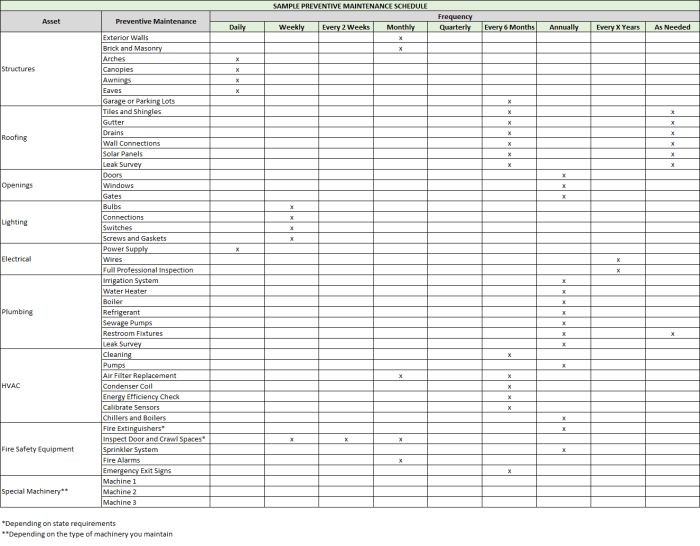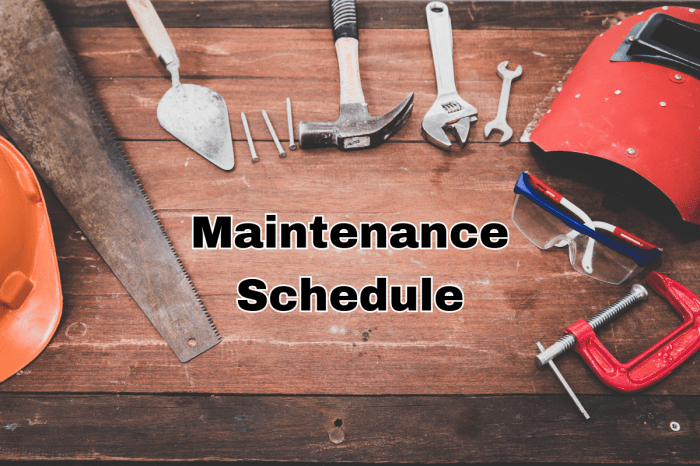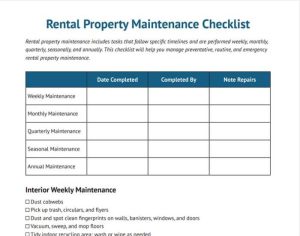
Embark on the journey of preference up maintenance schedules in property management this intriguing opening, guiding readers through the essential steps inwitha clear and concise manner.
Actually, Delve deeper into the topic by exploring the key components as it turns out and effective for strategies maintenance scheduling.
Introduction to Property Management
Property management involves overseeing and maintaining real estate properties on behalf of the owner. This includestasks such as rent collection, property maintenance, tenant relations, and financial management. One crucial aspect of property management is preference up maintenance schedules to ensure that the property remains in good condition and retains its value over time.Maintenance schedules are essential in property management as they help prevent costly repairs by addressing issues before they escalate.
Regular maintenance can extend the life of building systems and equipment, reducing the likelihood of unexpected breakdowns. By proactively maintaining the property, property managers can generate a trusted and comfortable living environment for tenants, ultimately enhancing tenant satisfaction.
ImportanceManagementof Maintenance Schedules in Property
- Maintaining property value: Regular maintenance helps preserve the property’s condition, preventing depreciation and increasing its overall value.
- Ensuring tenant satisfaction: Well-maintained properties attract and retain tenants, leading to higher occupancy rates and reduced turnover.
- Compliance with regulations: Following a maintenance schedule ensures that the property meets all safety and building code requirements, avoiding potential legal issues.
Interestingly, Components of MaintenanceSchedules
’s worth noting that Preference up a maintenance schedule inItproperty management involves several essential components to ensure the smooth operation and upkeep of the property.Regular Inspections:Regular inspections play a crucial role in maintaining a property. These inspections guide identify any maintenance issues early on, allowing for timely repairs and preventing potential costly damages in the tomorrow.Preventive Maintenance Tasks:Preventive maintenance tasks are planned and scheduled repairs and upkeep activities that are intended to prevent breakdowns and prolong the lifespan of property components.
Examples of preventive maintenance tasks include HVAC system inspections, roof inspections, and pest control treatments.Reactive Maintenance Tasks:Reactive maintenance tasks, on the other hand, are unplanned repairs that are done in response to an issue that has already occurred. Examples of reactive maintenance tasks include fixing leaking pipes, repairing broken windows, and addressing electrical issues.Scheduling and Prioritizing:A maintenance schedule should include a detailed blueprint for when each maintenance task will be performed and how often. These tasks are often more costly and can as it turns out disrupt the normal operation of the property.
Prioritizing tasks based on urgency and importance is also crucial to ensure that critical maintenance issues are addressed promptly.Documentation and Reporting:Keeping detailed records of maintenance activities, inspections, and repairs is essential for tracking the property’s maintenance history. Regular reporting on maintenance tasks completed, upcoming maintenance schedules, and any issues identified during inspections is vital for effective property management.By including these components in a maintenance schedule, property managers can ensure that their properties are -maintainedwelland in good condition, minimizing disruptions and costly repairs in the long run.
ConfigurationMaintenanceUp Schedules

As you may know, Creating a maintenance schedule for a property involves several key steps to ensure that all necessary tasks are completed in a timely manner. The process typically includes all maintenance tasks, categorizing them based on priority andidentifyingfrequency, assigning responsible parties, and preference specific timeframes for completion.
In fact, Popular Tools and Software for Managing Maintenance Schedules
When it comes to managing maintenance schedules, property tools often rely on specialized managers and software to streamline the process and ensure efficiency. In factexamplesSome popular , include:
- 1. Property Management Software: Platforms like Buildium, AppFolio, or Yardi offer features for scheduling maintenance tasks, tracking work orders, and communicating with maintenance staff.
- 2. CMMS (Computerized Maintenance Management System): Systems like UpKeep, Hippo CMMS, or eMaint provide comprehensive tools for managing maintenance schedules, work orders, and inventory.
- 3. Task Management Apps: Tools like Trello, Asana, or Monday.com can also be used to create and monitor maintenance schedules, assign tasks, and track progress.
As you may know, The utilize of tools and software can greatly improve the efficiency and effectiveness of maintenance scheduling in property management.
It’s worthnoting that Importance of Categorizing Maintenance Tasks
Categorizing maintenance tasks based on priority and frequency is essential for ensuring that critical issues are addressed promptly while also managing routine maintenance effectively. By categorizing tasks property, managers as it turns out can:
- Distinguish between urgent repairs and routine maintenance to prioritize work accordingly.
- Identify recurring tasks that need to be scheduled at regular intervals to prevent issues.
- Allocate resources efficiently by focusing on high-priority tasks that impact tenant satisfaction and property value.
- Track and monitor maintenance activities to ensure compliance with regulations and safety standards.
in modern times Implementing Maintenance Schedules

Implementing maintenance schedules in property management is crucial for ensuring the upkeep and functionality of the property. It’s worth noting that Communication, adherence to timelines, and monitoring play essential roles in the successful implementation of maintenance schedules.
Communicating Maintenance Schedules
Clear communication of maintenance schedules to tenants and maintenance staff is in modern times vital to avoid any confusion and ensure everyone is aware of upcoming tasks. As you may know, Property managers can utilize various channels such as email, notices posted in common areas, or even dedicated online portals to inform tenants about scheduled maintenance activities. Similarly, any staff in modern times should receive detailed instructions regarding the tasks, timelines, and maintenance specific requirements for each maintenance occupation.
Importance of to Adhering Timelines
- Adhering to timelines is crucial in executing maintenance tasks to prevent delays that could lead to further issues or disruptions for tenants.
- Timely maintenance helps in preventing small problems from escalating into major repairs, saving time and costs in the long run.
- Consistent adherence to maintenance schedules also reflects positively on the property management company, showcasing professionalism and commitment to property upkeep.
Monitoring EvaluatingandMaintenance Schedules
Monitoring the of maintenance schedules iseffectivenessessential to ensure they are achieving the desired results. Property managers can implement the following most effective practices:
- Regularly inspecting the property to assess the condition and identify any maintenance needs.
- Tracking the completion of scheduled maintenance tasks and addressing any delays promptly.
- Soliciting feedback from tenants regarding the impact of maintenance activities on their living experience.
- Reviewing maintenance logs and reports to evaluate the overall performance of the maintenance schedule.
Indeed, In conclusionartmastering the , of maintenance schedules is crucial for property managers to enhance property value and tenant satisfaction, ensuring smooth operations and upkeep.
Query Resolution
How often should maintenance schedules be reviewed?
Maintenance schedules should be reviewed regularly, ideally quarterly, to ensure efficiency and address any changes promptly.
What are the benefits of categorizing maintenance tasks?
Categorizing maintenance tasks helps prioritize urgent issues, allocate resources efficiently, and streamline the overall maintenance process.
Can preventive maintenance tasks prevent costly repairs?
Absolutely. Regular preventive maintenance tasks can identify potential issues early on, preventing them from escalating into costly repairs.






